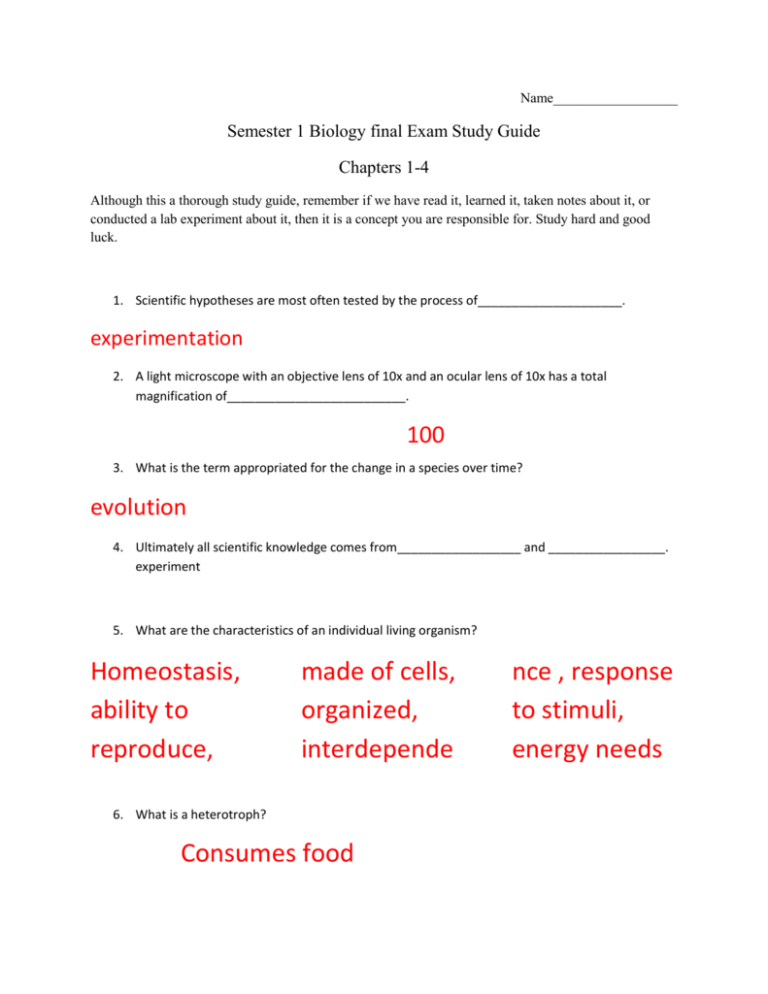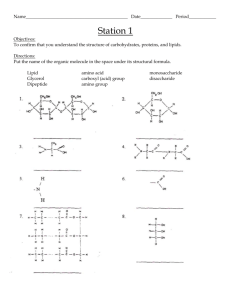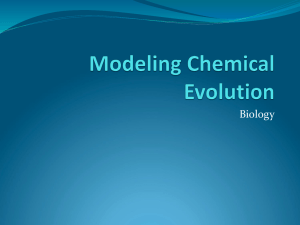Name__________________ Semester 1 Biology final Exam Study
advertisement

Name__________________ Semester 1 Biology final Exam Study Guide Chapters 1-4 Although this a thorough study guide, remember if we have read it, learned it, taken notes about it, or conducted a lab experiment about it, then it is a concept you are responsible for. Study hard and good luck. 1. Scientific hypotheses are most often tested by the process of_____________________. experimentation 2. A light microscope with an objective lens of 10x and an ocular lens of 10x has a total magnification of__________________________. 100 3. What is the term appropriated for the change in a species over time? evolution 4. Ultimately all scientific knowledge comes from__________________ and _________________. experiment 5. What are the characteristics of an individual living organism? Homeostasis, ability to reproduce, made of cells, organized, interdepende 6. What is a heterotroph? Consumes food nce , response to stimuli, energy needs 7. What determines the size of an organism? # of cells 8. What microscope can be used to view live specimens? Light microscope 9. All of the atoms of the same element have the same ________________________. # of protons 10. Two or more atoms of different elements are combined in definite proportions in a ____________________. Covalent bond 11. What is an acid? Give an example. Has more H+ than OH-, ph below 7. Lemon juice 12. What causes covalent bonds to form? Sharing of electrons 13. What determines the valence number of an atom? The number of electrons in the highest energy level 14. What is an isotope? An atom of an element with a different number of neutrons (also has a different mass) 15. Where is the majority of an atom’s mass found? In the nucleus 16. What happens when an atom is oxidized? Reduced? LEOGER It loses electron(s). Reduced…it gains electrons 17. Describe a base. pH above 7, more OH- than H+. 18. A solution with a pH of 6 [H+= 1.0x10-6] is how many times more basic is it than a solution with a pH of a 2[H+= 1.0x10-2] on the pH scale? 10,000 19. Ca(OH)2 has how many elements in it? How many atoms? 3 elements. 5 atoms 20. Carbon is atomic number 6 and has an atomic mass of 12.001. How many neutrons are in most atoms of Carbon? (The mass number is12) Mass number = protons + neutrons 6 neutrons 21. Most atoms of carbon have an atomic mass of 12. What would an atom of carbon that has an atomic mass of 13 be called? isotope 22. Balance the following equation: _____ C6H12O6 + __6__ O2 → __6__ CO2 + __6__ H2O 23. Blood is an example of a __________ because it can neutralize small amounts of acids and bases buffer 24. What is an enzyme? A protein that speeds up chemical reaction in living things 25. Calcium (Ca) has a valence number of +2. Chlorine has a valence number of -1. How will Ca and Cl combine in the correct chemical formula? CaCl2 26. What word describes when a molecule is attracted to water? hydrophilic 27. Why can water have no net charge but have slight charges in different parts of the molecule? Because it is polar, meaning the hydrogen end is slightly positive and the oxygen end is slightly negative. 28. Why does water move from the roots to the leaves of plants? Capillary action causes the water molecules to move up the stem toward the leaves. 29. When you mix motor oil and water, they immediately separate because: Because oil is hydrophobic 30. What properties of water make it so important for living things? Water’s ability to absorb large amounts of energy helps to keep cells at an even temperature 31. What element is always found in organic molecules? What other compounds are usually found in organic compounds? Carbon; others Hydrogen, Oxygen, and nitrogen 32. What causes ATP to release energy? How many phosphate groups does ATP have? (Hint the T stands for tri, unlike ADP, where the D stands for di) What is the function of ATP? It releases energy when it loses a phosphate group. It goes from 3 phosphates to 2 phosphates. 33. Why are fructose, glucose, and galactose referred to as isomers? They have the same chemical formulas, but different chemical structures 34. What shapes of molecules can carbon form? (pg 52) Straight chain, branched chain, ring 35. What types of molecules are joined by peptide bonds? What is the name of the molecule that is formed? Amino acids, form dipeptides 36. Describe the primary structure of a protein. Multiple polypeptide chains interacting with their R-group 37. What are the functions of proteins? Structure, transport, contractile strength 38. What are two examples of proteins in a living organism? Hair and skin 39. What is an enzyme? What would cause an enzyme to no longer work properly? Organic molecules that act as a catalyst 40. How many types of amino acids are in the human body? How many types of nucleotides are in DNA? 41. What compounds tend to form rings in aqueous solutions? Carbohydrates 42. Nucleotides contain what groups of molecules? Nucleic acids 43. Carbon has the ability to form a maximum of how many bonds? 4 44. Triglycerides contain how many fatty acid groups? 3 45. Sketch a phospholipid, a cholesterol and a triglyceride molecule. 46. What is the most common organic compound found in living things? Cellulose 47. Write and analogy to compare monosaccharides to carbohydrates and amino acids to proteins. You can figure this one out!! 48. What are important structural components of cell membranes? phospholipids 49. In making polymers, complex molecules are formed by the joining together of many ____________________ 50. monomers_______________. What is the organic polymer most responsible for the transmission of genetic information from parents to offspring? DNA 51. If the carbon atoms in a fatty acid chain are joined by single bonds except for 1 double bond, the fatty acid is ____ unsaturated_________________________. 52. Monosaccharides are composed of carbon, hydrogen, and oxygen in what ratio? (C:H:O) 1:2:1 53. What type of organic molecule ultimately serves as the principal energy source for most living organisms? Monosaccharides 54. Glucose and fructose are examples of_____ 55. Nearly all enzymes are _____ isomers_________________________. proteins_____________________ . (a type of organic compound) 56. Why is it that often only a small amount of enzyme is needed to speed up a chemical reaction? They are reused amino groups_____________ 57. All amino acid monomers contain the same ______ groups. 58. In fatty acids, the-COOH attached at the end of long hydrocarbon chain is polar and is called a ___________ carboxyl group_____________ group. 59. What discovery is Robert Hooke known for? That cork is composed of compartments he named cell ? Increases at the 60. When the volume of a cell increases, its surface area does what same rate 61. What are the main differences between prokaryotes and eukaryotes? Unlike eukarytoes, prokaryotes do not have a membrane bound nuclei. 62. What organelle contains genetic information for making proteins? ribosomes 63. What is the difference between vacuoles in plants and animals? Plants have a large central vacuole 64. What newly synthesized products are inserted into the ER for use in the cell, or modified to ship out? Proteins 65. What type of cells could you find cell walls in all? Plants 66. List the following in order from LARGEST to SMALLEST: organ, organ system, atom, cell, tissue. Atom, organelle, cell, tissue, organelle 67. What function do mitochondria carry out for the cell? They are the site of energy production (ATP) in the cell 68. What are microfilaments and microtubules made of? Both are part of the cytoskeleton 69. What are all the functions of the cell membrane? Provide protection for the cell, receive and transmit messages, form pseudopods to engulf foreign material, form a semipermeable layer around the cell.











